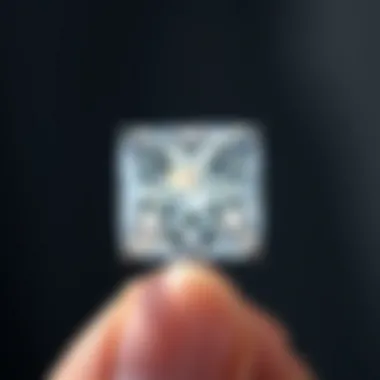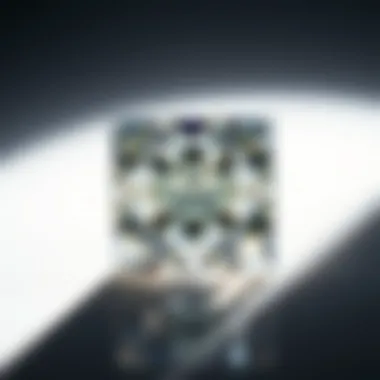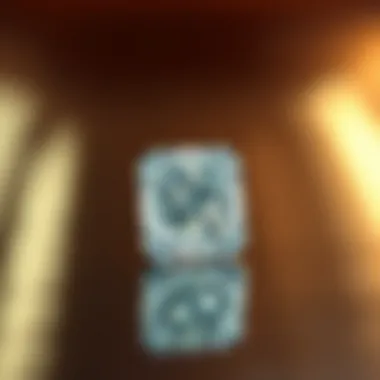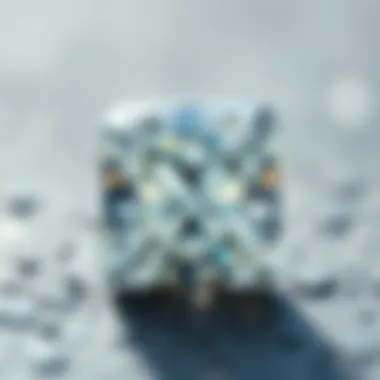Factors That Influence the Value of a 1 Carat Princess Cut Diamond


Intro
When it comes to gemstones, diamonds stand out as the most coveted option. Their sparkle has captivated hearts for centuries, but not all diamonds are created equal. Among the different cuts, the princess cut has carved its niche, especially when we discuss a one-carat version. Understanding the value of this specific diamond isn't as cut and dry as one might think. It encompasses a swirl of factors including cut quality, color, clarity, and market positioning.
In the world of gemstones, information is your best ally. If you're thinking about purchasing a one-carat princess cut diamond, you’ll benefit from knowing how each factor influences its worth. After all, investing in a diamond is like stepping into a treasure hunt; knowledge of what you seek helps in making the right pick.
As we delve deeper, this article will illuminate important aspects, enriching your decision-making process and arming you with insights to navigate the diamond purchasing journey with confidence.
Intro to Princess Cut Diamonds
In the realm of gemstones, princess cut diamonds stand out for their modern appeal and striking brilliance. This article dives into the intricate facets and factors that contribute to the overall value of a one-carat princess cut diamond. Understanding these characteristics is crucial for both enthusiasts and potential buyers.
The princess cut, with its unique blend of square shape and radiant sparkle, has become a sought-after choice for engagement rings and other fine jewelry. It serves as a perfect representation of both elegance and contemporary design. By appreciating the significance of the princess cut, buyers can make informed decisions that align their tastes with their budget.
History of the Princess Cut
The princess cut is a relatively recent innovation in the world of diamond cutting, first developed in the late 20th century. Its creation is attributed to Betzalel Ambar and Israel Itzkowitz, who aimed to maximize the brilliance and size of the diamond while maintaining an appealing square shape. Before the princess cut gained popularity, the round brilliant cut dominated the market, but the princess cut emerged as a fresh alternative, offering an edgier look without sacrificing beauty.
This cut combines a modern aesthetic with an ancient art—transforming rough diamonds into striking gems that captivate the beholder. By the mid-1980s, the princess cut had firmly established itself within fine jewelry, often heralded for its versatility and charm.
Defining Characteristics
A one-carat princess cut diamond boasts several distinctive features that are integral in determining its value and allure:
- Shape: The princess cut has a square or rectangular shape that differs from the classic round shape, appealing to those who prefer contemporary designs.
- Brilliance: This cut is engineered to enhance light dispersion, resulting in a dazzling sparkle. When properly cut, the diamond reflects light beautifully, making it attractive at various angles.
- Facets: With generally 57 facets, the princess cut captures and refracts light, contributing to its brilliance and fire. The arrangement of these facets allows for a unique visual experience that can often outshine other cuts of similar carat weight.
- Proportions: Dimensions play a pivotal role in assessing a diamond’s beauty and value. A well-proportioned princess cut typically features a length-to-width ratio between 1.0 to 1.1, balancing the appearance of the stone.
In sum, understanding the history and characteristics of the princess cut diamond provides a solid foundation for evaluating its value. It's not just about the physical attributes but also how they reflect individual preferences and market trends. The journey into the world of diamonds is one steeped in craftsmanship, beauty, and personal connection.
Factors Influencing Diamond Value
Determining the value of a one-carat princess cut diamond goes beyond mere aesthetics; it encompasses various factors deeply embedded in the gem trade. Understanding these elements is crucial for any potential buyer or gem enthusiast. Each facet, from carat weight to clarity, contributes to the overall value, providing insights into what makes a diamond truly remarkable.
Understanding Carat Weight
Carat weight is often the first item on the shopping list when it comes to diamonds. Simply put, a carat is a unit of weight equal to 200 milligrams. When buyers hear about a one-carat diamond, they're considering a weight that generally holds significance in the market. However, it’s essential not to confuse weight with size. A one-carat princess cut diamond may appear smaller than a round brilliant diamond of the same weight, due to its particular shape.
- Market Perception: Larger stones often fetch higher prices. This perception drives demand at different tiers.
- Size Perception: Interestingly, a well-proportioned diamond can look bigger than its actual carat weight when set in jewelry. A skilled jeweler can enhance the appearance through a thoughtful setting choice.
Evaluating Cut Quality
Cut quality is arguably the most significant aspect influencing a diamond's brilliance. Unlike carat weight, the cut is not a physical measurement but reflects the gemcutter's skill in shaping and faceting the diamond. A high-quality cut allows light to bounce within the stone, creating enchanting sparkle.
- Grading Scales: Cut quality is typically graded on a scale ranging from Excellent to Poor. This grading affects both aesthetic appeal and monetary value.
- Impact on Sparkle: An inferior cut can render a diamond lifeless and uninspiring, even if it’s of high carat weight. Brightness and fire are often sacrificed for weight, so always check the cut when comparing diamonds.
Assessing Color Grading
Color grading in diamonds measures the absence of color, with truly colorless diamonds (D grade) being the most sought after. As the grading scale moves from D to Z, diamonds exhibit various tints—an unsightly yellow or brown shade can detract from value.
- Visual Appeal: Even slight color variations can impact a diamond’s visual allure, thus influencing buyer preference. When looking at stones, comparing color side by side can act as a helpful tool.
- Market Preferences: Diamonds in the G-H range are often preferred for their combination of value and visual clarity. These stones are more affordable while still appearing nearly colorless, making them very popular choices.


Clarity and its Impact on Value
Clarity refers to the absence of inclusions and blemishes; it’s about the purity of the diamond. Graded using similar scales as color, clarity levels can range from Flawless (no inclusions visible under 10x magnification) to Included (inclusions visible without magnification).
- Inclusion Effects: Even minor inclusions can impact the overall beauty of a diamond, making clarity an important consideration when assessing value.
- Price Fluctuations: Higher clarity usually correlates with increased cost. Buyers should weigh their options between clarity and other factors, depending upon personal preferences and budget.
"Remember, a diamond's allure is not solely defined by its carat weight but rather by a harmonious blend of characteristics that define its overall charm."
When investing in a one-carat princess cut diamond, remember that understanding these factors can guide better decisions. Whether it’s carat weight or the intricate measures of color, each component weaves into the larger narrative of worth and beauty.
Market Trends for One Carat Diamonds
Understanding the trends in the diamond market is essential for anyone considering the purchase of a one-carat princess cut diamond. These insights not only help in navigating the complex market but also provide guidance on value—an aspect crucial for both personal purchase decisions and potential investment opportunities. Awareness of market trends allows consumers to grasp how diamonds are priced, what characteristics might be in demand, and which marketplaces are thriving.
Furthermore, market trends influence how much you might expect to pay for a diamond today versus what it might be worth in the future. This multifaceted landscape is shaped by a variety of factors including supply chains, retail dynamics, and the shift towards online shopping.
Supply and Demand Dynamics
The fundamental principle of supply and demand applies significantly to diamonds, including the one-carat princess cut. When you're in the market for a diamond, you'll want to consider how many stones are available versus how many buyers there are. Currently, the diamond supply can fluctuate depending on the economic situation and consumer behavior.
Over recent years, the growth of synthetic diamonds has also influenced supply chains. More affordable options are becoming more common, and while they have their own market, many traditional consumers still prefer natural diamonds, affecting their demand. This situation can lead to some interesting pricing shifts when comparing lab-grown and natural diamonds.
It's important to research:
- Market demand: Are more buyers looking for smaller stones like the one-carat princess cut?
- Supply issues: Are there any disruptions in mining or manufacturing sectors that could affect the availability for your desired diamond type?
Popular Retail Settings
When it comes to purchasing diamonds, the retail environment is crucial. Different settings provide various selection, ambiance, and expertise. For one-carat diamonds, understanding where to shop is key.
- Specialized Jewelers: These stores often have knowledgeable staff that can provide detailed insights into specific diamonds. You might pay a premium here, but the service can compensate for that.
- Department Stores: They tend to have a broad selection but typically offer less personalized service. It can be a convenient option for many.
- Wholesale Diamonds: Purchasing from wholesalers can present significant savings. However, buyers need to do their homework to ensure they receive quality stones and fair prices.
- Auction Houses: For unique or antique pieces, auctions can be an exciting avenue, offering the chance for rare finds.
Knowing the type of retailer that best fits your preferences can influence your buying decisions significantly.
Online vs. Physical Marketplaces
Deciding between purchasing online or from a physical store can impact your diamond buying experience. Both options have their pros and cons, but the trend is leaning towards online shopping due to convenience and often more competitive pricing.
Online Marketplaces:
- Accessibility: A vast range of options is available at your fingertips.
- Reviews and Comparisons: You can easily gather information and read customer reviews to gauge quality and service.
- Price Comparison: It is easier to compare prices from different retailers to ensure you're getting the best deal.
Physical Storefronts:
- Tangible Experience: There’s something to be said about seeing and touching the diamond before purchase.
- Personal Interaction: You can immediately ask questions and engage with knowledgeable staff.
- Instant Ownership: You leave with your purchase in hand, eliminating shipping times.
Ultimately, both avenues have their merits, and understanding the trending preferences in these marketplaces will help gauge where the best deals might be found.
In summary, staying informed about market trends for one-carat diamonds sheds light on the dynamics that can affect pricing and availability, giving you the upper hand when making a purchase.


Certification and Its Importance
When it comes to purchasing a diamond, especially a one-carat princess cut, the notion of certification often pops up. This piece sheds light on why certification holds tremendous importance, focusing on trust, quality, and investment security.
The process of buying a diamond can feel like navigating through a maze, with various factors that might demand attention. But a certified diamond often comes with a sigh of reassurance. Buyers need to know that they are making an informed choice. Certifications substantiate the claims made by dealers and provide an unbiased evaluation of the diamond’s characteristics.
Role of Gemological Institutes
Gemological institutes play a pivotal role in the diamond industry. These organizations are tasked with evaluating and grading diamonds based on several criteria. They use advanced technology and skilled professionals to assess each diamond meticulously, providing a detailed report.
These certificates usually include:
- Carat weight: confirming the actual weight of the diamond.
- Cut quality: evaluating how well the diamond has been cut, affecting its brilliance.
- Color grade: measuring the color quality of the diamond from colorless to various tones.
- Clarity grade: indicating the presence of blemishes or inclusions, with grades ranging from flawless to included.
Some prominent gemological institutes include the Gemological Institute of America (GIA) and the International Gemological Institute (IGI). Each of these ensures neutrality and rigorous grading standards, enabling buyers to trust their investments. Gemstones certified by recognized institutes often command higher prices due to the assurance of quality and authenticity they carry.
Understanding Certification Reports
Certification reports can seem like a jumble of technical jargon, yet they provide you with essential insights into what you are purchasing. Let's break down how to interpret these reports clearly.
Key Components of a Certification Report:
- Certificate Number: Each certified diamond will have a unique identification number. Always verify it against the gemological institute's website.
- Attributes Overview: A concise summary usually appears at the top, giving you instant access to critical information about the diamond’s cut, color, clarity, and carat weight.
- Detailed Grading: You’ll find detailed descriptions of the grading parameters. Be sure to familiarize yourself with the various scales, as these can influence your buying decision.
- Photographs or Diagrams: Some reports will include images or laser inscriptions demonstrating the diamond's inclusions and overall appearance.
“A certified diamond isn’t just another rock; it’s a representation of authenticity and assurance, standing behind your investment.”
Understanding these elements can significantly enhance your buying experience. Having a strong grasp of what that certificate says not only protects your wallet but also assures you that what you are buying is worth every penny.
Consumer Preferences and Buying Strategies
When it comes to selecting a one carat princess cut diamond, consumer preferences and buying strategies play a critical role. Understanding these influences helps buyers navigate the often overwhelming diamond market while ensuring they make choices that resonate personally and financially. Whether buying for an engagement, an anniversary, or as an investment, the way consumers approach this purchase can greatly affect their satisfaction and the overall value they derive from their decision.
Factors Influencing Buyer Decisions
Several factors can influence a buyer's decision when choosing a one carat princess cut diamond. Here are some key considerations that often come into play:
- Aesthetic Preferences: The way a diamond looks is undeniably important. From sparkle to the overall shape, aesthetic appeal can guide buyers in their choices.
- Budget Constraints: Every budget varies. Setting a budget before browsing can help narrow down choices and focus on diamonds that fit within financial comfort zones.
- Purpose of Purchase: The reason behind the purchase also shapes preferences. An engagement ring might lean towards elegance and romance, while an investment could prioritize quality and certification.
- Knowledge and Research: Consumers today have access to an abundance of information on diamond quality and market prices. Better-informed buyers are often more confident in their choices.
- Peer Influence: Recommendations from friends or family can sway decisions significantly. This is where personal experiences come into play, shaping preferences based on trustworthy advice.
Strategies for Negotiation
Negotiating the purchase of a diamond can feel daunting, but a few smart strategies can make the process smoother and more successful:
- Do Your Homework: Knowledge is power. Before entering a store, familiarize yourself with the current market prices of one carat diamonds and the specifics of the diamond you want. This gives you a solid foundation for negotiating.
- Ask About Discounts: Don’t hesitate to inquire about promotions, discounts, or upcoming sales events. Sellers often have more flexibility than they initially appear to.
- Be Prepared to Walk Away: Sometimes the best negotiating tactic is the confidence to seek other options. If a deal doesn’t feel right, shopping around can also highlight how particular sellers value their diamonds.
- Consider Timing: Insider tip—timing can play a big role in negotiations. Shopping on weekdays or during slower months often gives buyers more leverage, as sellers may be more eager to close deals during quieter times.
- Know the Seller: Look for reputable sellers who provide certification and clear information on their products. Approaching a well-reviewed jeweler may not only offer peace of mind but also open the door for more favorable negotiations without feeling pressured.
Utilizing these factors and strategies can empower consumers in their quest to find the perfect one carat princess cut diamond. By blending personal preferences with informed buying techniques, individuals can ensure that their purchase reflects both their emotional intentions and financial sensibilities. For those interested in diving deeper into gemology, resources such as Wikipedia or Britannica can provide extensive background knowledge.
The Emotional Value of Diamonds
The emotional significance of diamonds unfolds beyond their physical beauty; it’s woven into moments shared and memories held dear. When considering a one-carat princess cut diamond, the intrinsic value it brings to a relationship is paramount. Each diamond resonates with the sentiment of commitment, love, and life’s milestones. It’s these emotions that often elevate a diamond’s worth well above its monetary value.


Symbolism and Sentimentality
Diamonds, particularly those of significant size like a one-carat princess cut, have long been seen as symbols of eternal love and commitment. These gemstones shine bright in the context of engagement rings and wedding bands, often serving as a testament to one’s promise and devotion. The phrase “A diamond is forever” encapsulates this profound sentiment, illustrating how these stones are not just ornaments but vessels of emotion.
Moreover, the princess cut, with its modern edges and symmetrical facets, embodies empowerment and individuality. Buyers are drawn to this cut not only for its brilliance but also for what it represents: a break from tradition, a statement of taste, and a celebration of one’s personal journey. It combines the classic allure of a diamond with a contemporary flair, resonating deeply with those who choose this path.
"The diamond serves as a metaphor for relationships; enduring, radiant, and distinctly unique."
Cultural Significance
Diamonds hold a treasured place across diverse cultures. In many societies, they are more than just gemstones; they are integrated into rituals and traditions. For instance, in Western cultures, a diamond engagement ring is nearly mandatory, symbolizing a lifelong commitment. Meanwhile, in some Eastern cultures, diamonds are gifted as ceremonial tokens during important life events, portraying prosperity and good fortune.
Additionally, the princess cut diamond has gained prominence in popular culture, often worn by celebrities and featured in films, amplifying its desirability. This cultural representation serves as a social signal, denoting success and stability. Buyers are often informed not just by the attributes of the stone itself but also by its place within the larger narrative of societal values.
Pros and Cons of Investing in Diamonds
When it comes to investing in diamonds, especially a one-carat princess cut diamond, potential investors need to weigh the positives and negatives. This section explores both sides, offering insight into what drives value while highlighting critical considerations for those thinking about making a purchase.
Potential for Appreciation
Diamonds have the reputation of being a stored value, much like gold. While they may not appreciate as predictably as some stocks or real estate, certain diamonds can appreciate significantly over time. Here are some points to consider:
- Rarity: Unique diamonds—those with uncommon colors or exceptional clarity—tend to hold or increase their value over time. The 1 carat princess cut can be a desirable choice due to its blend of simplicity and elegance.
- Market Demand: The luxury market has seen consistent demand for diamonds, driven often by emotional connections that consumers have with them. Special occasions like engagements and anniversaries fuel ongoing interest.
- Fine Cut and Quality: The quality of the diamond's cut plays a major role in appreciation potential. A superiorly cut princess diamond will often approach higher demand, thus more future worth.
As one can see, investing in a high-quality, well-cut diamond could yield appreciable returns if the right market conditions line up. As with any investment, however, knowledge is key.
Investing in diamonds is not just about the physical stone; it's also about the emotions and stories they carry.
Liquidity Concerns
One of the notable challenges of investing in diamonds is liquidity. Unlike stocks or bonds, diamonds don’t have a straightforward or quick resale process. Here are some liquidity-related challenges:
- Market Size: The diamond market is relatively small compared to other investment avenues. A specific diamond might take a long time to find the right buyer who recognizes its value.
- Valuation Complexity: Determining the selling price can often be subjective. While established appraisers can offer a rough idea of worth, personal sentiments attached to a diamond can make pricing tricky.
- Transaction Costs: Selling a diamond often involves brokerage fees, or commissions to jewelers which can chip away at profit margins, making it a less liquid asset than stocks.
Culmination: Making an Informed Choice
As we wrap up this exploration into the world of one-carat princess cut diamonds, the crux of our discussion lies in the concept of making an informed choice. Taking a dive into this intricate subject not only equips prospective buyers with knowledge but also serves as a powerful tool in navigating the diamond market. Here we distill the essential components that contribute to understanding the value of these gemstones and the implications of one's purchase.
Summary of Key Insights
In evaluating a one-carat princess cut diamond, numerous factors intertwine to dictate its overall worth and desirability. Here’s a nuanced recap that captures the essence:
- Cut Quality: A diamond's cut can make or break its charm, impacting brilliance and sparkle.
- Color Grading: The shades vary from colorless to subtly tinted; seeking a higher grade typically leads to greater beauty.
- Clarity: The fewer inclusions or blemishes a diamond has, the higher its value and visual appeal.
- Market Trends: Keeping an ear to the ground helps potential buyers anticipate price fluctuations and popular trends.
- Certification: Third-party evaluation adds credibility and trustworthiness to the diamond's quality claims, making it a safer purchase.
This well-rounded grasp helps illuminate the complexities of a one-carat diamond’s value and enhances the decision-making process when it comes to purchasing.
Final Thoughts on Diamond Selection
Selecting a one-carat princess cut diamond involves more than just admiring its luster. It demands careful consideration of personal values, aesthetic desires, and budget constraints. Here are some points to contemplate:
- Emotional Significance: Understand that every diamond carries emotional weight, celebrating milestones or marking heartfelt commitments.
- Personal Taste: Evaluate where the diamond will be worn and who will wear it. Preferences can vary greatly.
- Investment: Gems can also serve as a financial asset, but one must be wary of markets that can be fickle.
Navigating through the gemological labyrinth can feel overwhelming at times, but armed with knowledge, consumers can find themselves in a much more confident position. Ultimately, making an informed choice not only reflects personal satisfaction but also secures a future heirloom that carries both beauty and meaning.
"Jewels are not just items of luxury; they reflect stories, emotions, and moments of life.”
For those diving deeper, consider visiting references like Gemological Institute of America or exploring community insights on Reddit's gemology sub to learn further about diamonds and their investment potential.



